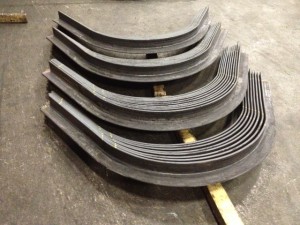Contract manufacturers (also called “job shops”) are often presented with requests for quotations from original equipment manufacturers (OEMs). For example, a company that specializes in curving metals might be asked to price custom rolled angle iron to become component parts of a snow plow. The purchasing agent might want to know the price breaks for various quantities, say 10, 50 or 100 pieces.

In order to provide a quotation, a contract manufacturer would probably start by computing his or her cost. Typically there are three main costs that need to be factored in: labor, raw material, and transportation.
With varying quantities, labor costs per piece may vary. An important component of labor costs is set-up time. If only a few parts are ordered, the set-up time could be a significant part of the total cost. On the other hand, when many parts are ordered, the set-up time can be amortized over all the parts thereby reducing the cost per piece.
Many companies who are introducing such programs as lean manufacturing and just-in-time programs strive to reduce set-up time significantly even to the point of eliminating set-up time. One way, but not the only way, of eliminating set-up time is to have a machine dedicated to producing a single part. If set-up time is reduced to an insignificant factor or eliminated altogether, then–at least as set-up time (and cost) is concerned–a contract manufacturer would have the same costs if it were making 5 or 100 parts.
Another cost input is raw material (assuming that the contract manufacturer is providing the material). Quantity discounts are sometimes granted for larger orders of material in which case per-piece costs can be reduced. Buying a large quantity from a steel mill is usually less expensive than buying from a service center. But mills typically require the purchase of a full, 40,000lb truckload of material. On the other hand, mills will often provide material in special lengths which might allow near-net use of the material needed for a given project.
Additional factors which affect the per-piece cost difference between ordering large and small quantities include shipping costs (a large order would probably have a smaller per-piece shipping cost), the transaction costs of processing orders, handling costs, and inventory costs to name just a few.
For the OEM, inventory costs include not just the investment in dollars but also the investment in storage space. Companies driven by just-in-time production techniques generally prefer having small quantities stored at their point-of-use, ready to be incorporated into a quick-response manufacturing process.
In conclusion, a savvy purchasing agent will weigh and consider what combination of a competitive price, quick response delivery, transactional ease, and enhanced productivity will provide the highest value for his company when he or she calculates the optimal economic order quantity
Of course cost is an important, but not the only, factor in pricing goods and services. A contract manufacturer will also consider risks associated with the job, the market, the attractiveness of a large order, the opportunity for repeat business, and the chance to bid on additional work from the OEM. A good contract manufacturer dealing with varied industries and types of companies will have the flexibility to cater its business towards its customers’ specific needs. Certain industries may be more price sensitive than time sensitive, while others may require speedy delivery more than low price. Communication with the customer is critical for a contract manufacturer to provide the greatest value.







